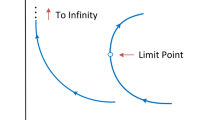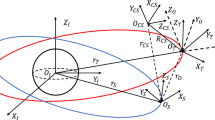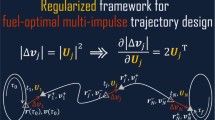Abstract
This paper presents a guidance solution of relative motion between two spacecraft using relative classical orbital elements for on-board implementation purposes. The solution is obtained by propagating the relative orbital elements forward in time using a newly formulated state-transition matrix, while taking into account gravitational field up to the fifth harmonic, third-body effects up to the fourth order and drag, then calculating the relative motion in the local-vertical-local-horizontal reference frame at each time-step. Specifically, utilizing Jacobian matrices evaluated at the target spacecraft’s initial orbital elements, the solution proposed in this paper requires only a single matrix multiplication with the initial orbital elements and the desired time to propagate relative orbital elements forward in time. The new solution is shown to accurately describe the relative motion when compared with a numerical simulator, yielding errors on the order of meters for separation distances on the order of thousands of meters. Additionally, the solution maintained accurate tracking performance when used within a back-propagation, or terminal-point, guidance law.



















Similar content being viewed by others
References
Appendix, A.: Newton–Raphson Method. Wiley, Hoboken (2003). https://doi.org/10.1002/0471458546.app1
Brouwer, D.: Solution of the problem of artificial satellite theory without drag. Astronom. J. 64(1274), 378–396 (1959). https://doi.org/10.1086/107958
Clohessy, W.H., Wiltshire, R.S.: Terminal guidance system for satellite rendezvous. J. Aeros. Sci. 27(9), 653–658 (1960). https://doi.org/10.2514/8.8704
Cook, G.E.: Luni-solar perturbations of the orbit of an earth satellite. Geophys. J. 6(3), 271–291 (1962). https://doi.org/10.1111/j.1365-246X.1962.tb00351.x
Danielson, D.A.: Semianalytic Satellite Theory. Master’s Thesis, Naval Postgraduate School. Monterey, California (1995)
Domingos, R.C., deMoraes, R.V., Prado, A.F.B.D.A.: Third-body perturbation in the case of elliptic orbits for the disturbing bodies. Math. Probl. Eng. 2008. https://doi.org/10.1155/2008/763654 (2008)
Giacaglia, G.E.O.: Lunar perturbations of artificial satellites of the earth. Celest. Mech. Dyn. Astron. 9, 239–267 (1972)
Gim, D.W., Alfriend, K.T.: State transition matrix of relative motion for the perturbed noncircular reference orbit. J. Guid. Cont. Dynam. 26 (6), 956–971 (2003). https://doi.org/10.2514/2.6924
Guffanti, T., D’Amico, S., Lavagna, M.: Long-term analytical propagation of satellite relative motion in perturbed orbits. AAS Spaceflight Mechanics Proceedings 160 (2017)
Xu, G., Xu Tianhe, W.C., Yeh, T.K.: Analytic solution of satellite orbit disturbed by atmospheric drag. Mon. Not. R. Astron. Soc. 410(1), 654–662 (2010)
Gurfil, P., Kasdin, N.J.: Nonlinear modeling of spacecraft relative motion in the configuration space. J. Guid. Cont. Dynam. 27(1), 154–157 (2004). https://doi.org/10.2514/1.9343
Gurfil, P., Kholshevnikov, K.V.: Manifolds and metrics in the relative spacecraft motion problem. J. Guid. Cont. Dynam. 29(4), 1004–1010 (2006). https://doi.org/10.2514/1.15531
Gurfil, P., Kholshevnikov, K.V.: Distances on the relative spacecraft motion manifold. AIAA Guidance, Navigation and Control Conference and Exhibit (San Francisco, CA. AIAA paper 2005–5859) (2005)
Hamel, J.F., Lafontaine, J.D.: Linearized dynamics of formation flying spacecraft on a j2-perturbed elliptical orbit. J. Guid. Cont. Dynam. 30 (6), 1649–1658 (2007)
Hill, G.: Researches in the lunar theory. Am. J. Math. 1, 5–26 (1878)
Inalhan, G., Tillerson, M., How, J.: Relative dynamics and control of spacecraft formations in eccentric orbits. J. Guid. Cont. Dynam. 25(1), 48–59 (2002). https://doi.org/10.2514/2.4874
Izsak, I.G.: Periodic drag perturbations of artificial satellites. Astronom. J. 65(5), 355–357 (1960)
Kaula, W.M.: Development of the lunar and solar disturbing functions for a close satellite. Astronom. J. 67, 300–303 (1962). https://doi.org/10.1086/108729
Koenig, A.W., Guffanti, T., D’Amico, S.: New state transition matrices for spacecraft relative motion in perturbed orbits. J. Guid. Cont. Dynam. 40(7), 1749–1768 (2017). https://doi.org/10.2514/1.G002409
Kozai, Y.: On the effects of the sun and moon upon the motion of a close earth satellite. Smithsonian Astrophysical Observatory (Special Report 22) (1959)
Kozai, Y.: The gravitational field of the earth derived from motions of three satellites. Astronom. J. 66(1). https://doi.org/10.1086/108349 (1961)
Kozai, Y.: A new method to compute lunisolar perturbations in satellite motions. Smithsonian Astrophysical Observatory pp. 1–27 (Special Report 349) (1973)
Kuiack, B., Ulrich, S.: Nonlinear analytical equations of relative motion on j2-perturbed eccentric orbits. AIAA J. Guid. Cont. Dynam. 41(11), 2666–2677 (2017). https://doi.org/10.2514/1.G003723
Lawden, D.F.: Theory of satellite orbits in an atmosphere. d. g. king-hele. butterworths, london. 1964. 165 pp. diagrams. 30s. J. R. Aeronaut. Soc. 68(645), 639–640 (1964)
Liu, J.J.F.: Satellite motion about an oblate earth. AIAA J. 12 (11), 1511–1516 (1974). https://doi.org/10.2514/3.49537
Mahajan, B., Vadali, S.R., Alfriend, K.T.: State-transition matrix for satellite relative motion in the presence of gravitational perturbations. J. Guid. Cont. Dynam. 1–17. https://doi.org/10.2514/1.G004133 (2019)
Martinusi, V., Dell’Elce, L., Kerschen, G.: First-order analytic propagation of satellites in the exponential atmosphere of an oblate planet. Celest. Mech. Dyn. Astron. 127(4), 451–476 (2017)
Musen, P., Bailie, A., Upton, E.: Development of the lunar and solar perturbations in the motion of an artificial satellite. NASA-TN D494 (1961)
NASA: Spaceflight revolution: The odyssey of project echo (Accessed: January 2019). https://history.nasa.gov/SP-4308/ch6.htm (2019)
Prado, A.F.B.A.: Third-body perturbation in orbits around natural satellites. J. Guid. Cont. Dynam. 26(1), 33–40 (2003). https://doi.org/10.1155/2008/763654
Schaub, H.: Incorporating secular drifts into the orbit element difference description of relative orbit. Adv. Astronaut. Sci. 114, 239–258 (2003)
Schaub, H., Junkins, J.L.: Analytical mechanics of space systems. AIAA Amer. Instit. Aeronaut. Astronaut. 593–673 (2018)
Sengupta, P., Vadali, S.R., Alfriend, K.T.: Averaged relative motion and applications to formation flight near perturbed orbits. J. Guid. Cont. Dynam. 31(2), 258–272 (2008). https://doi.org/10.2514/1.30620
Smith, D.E.: The perturbation of satellite orbits by extra-terrestrial gravitation. Planet. Space Sci. 9(10), 659–674 (1962). https://doi.org/10.1016/0032-0633(62)90125-3
Roscoe, T.C.W., Vadali, S.R., Alfriend, K.T.: Third-body perturbation effects on satellite formations. J. Astronaut. Sci. 60(3), 408–433 (2013). https://doi.org/10.1007/s40295-015-0057-x
Tooley, C.R., Black, R.K., Robertson, B.P., Stone, J.M., Pope, S.E., Davis, G.T.: The magnetospheric multiscale constellation. Space Sci. Rev. 199(1), 23–76 (2016). https://doi.org/10.1007/s11214-015-0220-5
Vallado, D.A.: Fundamentals of astrodynamics and applications, 2nd edn., pp 80–81. El Segundo, Microcosm Press (2001)
Vinti, J.P.: Zonal harmonic perturbations of an accurate reference orbit of an artificial satellite. Math. Math. Phys. 67B(4) (1963)
Watson, J.S., Mislretta, G.D., Bonavito, N.L.: An analytic method to account for drag in the vinti satellite theory. Goddard Space Flight Center, Greenbelt, Maryland 71–92 (1974)
Author information
Authors and Affiliations
Corresponding author
Additional information
Publisher’s Note
Springer Nature remains neutral with regard to jurisdictional claims in published maps and institutional affiliations.
Rights and permissions
About this article
Cite this article
Chihabi, Y., Ulrich, S. Perturbed State-Transition Matrix for Spacecraft Formation Flying Terminal-Point Guidance. J Astronaut Sci 68, 642–676 (2021). https://doi.org/10.1007/s40295-021-00272-1
Accepted:
Published:
Issue Date:
DOI: https://doi.org/10.1007/s40295-021-00272-1




